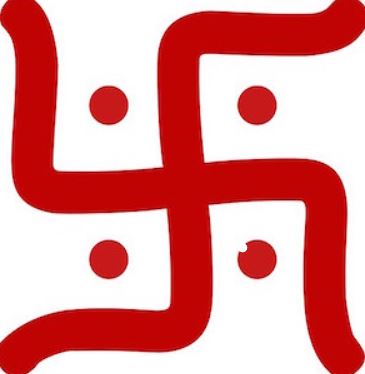One of humanity’s most enduring, sacred symbols, the harbinger of good luck and prosperity, the epitome of life and regeneration, and the limbs of the governing wheel of Dharma, the Swastika adorns the house of every Hindu, far and wide. The paradigm of spiritual purity and well-being, the Swastika stood the test of time and remains one of the most powerful and enduring symbols of peace, love, prosperity, and good luck today.

(Public Domain)
What is the Swastika?
The swastika is an ancient religious icon in Hinduism, Buddhism, and Jainism, the Swastika or Sauvastika is the ultimate symbol of divinity and spirituality. It is also considered to be a symbol of auspiciousness, good luck, and prosperity and hence, often makes an appearance in Hindu marriages and religious ceremonies. Owing to its ability to attract prosperity and luck, Hindus often adorn the entrance of their houses with Swastika imagery.
In addition to this, Swastika’s are said to ward off evil and ill-fortune and hence, are often spotted on cars, autorickshaws, offices, and houses. With the inflow of tourists to India and the association of the Swastika with good luck and well-being, it quickly became one of the most widely used symbols in the western world. Companies began to use it on their products, people used to wear swastika badges and adorn their possessions with Swastika stickers.
However, the use of the Swastika in the western world slowly came to a halt with the rise of Hitler and the Nazis in the 1930s. German scholars believed that Sanskrit and german and concluded that Indians and Germans shared a common ancestor- The Aryans. Soon, the Swastika came to be associated with the Nazis and the widespread terror they caused, causing the use of the Swastika in the west to come to a screeching halt.
However, the true meaning of the Swastika can be found in the ancient Hindu texts. Despite the misunderstandings over the symbol, it continues to act as a symbol of hope and goodwill for millions of Indians across the world today. To Hindus, the Swastika symbolizes divinity, auspiciousness, good luck, protection, and pure good.
Significance of the Swastika in Hinduism
One of the most significant Hindu symbols, the Swastika adorns the entrances of Hindu homes, temples, books, cards, and so on. Considered to be the harbinger of good luck, the Swastika is also incorporated into various Hindu iconographies- ranging from Mandalas to the representation of deities.
In addition to this, the Swastika is closely associated with the Hindu festival of Diwali- the festival of lights. During Diwali, Swastika’s are drawn with Rangoli (colored sand), formed using diyas or lights on the floors, and are placed on the walls and hung from the doors to bring good luck and prosperity into the house.

(Public Domain)
A Swastika is in the form of a chiral arrangement of bent crosses, either facing the clockwise or anti-clockwise direction. The right hand or the clockwise facing swastika is considered to be a “solar symbol” as it mimics the course of the Sun throughout the day.
The left-hand or anti-clockwise facing Swastika, on the other hand, represents the darkness of the night, mystical activities and practices, and Goddess Kali, the Goddess of Destruction.
10 Facts about the Swastika
1. It is considered to be Humanity’s greatest symbol of love and prosperity
The Swastika has firmly established its roots in the ancient Vedic texts and is derived from the Sanskrit words “Su”, meaning “good” or “well” and “Asti”, meaning “it is”. This directly translates to “that which is good”, or “it is good”- a testament to its ties to good luck and prosperity. Due to this and the reverence of the Hindu and Buddhist people towards this symbol, it is considered to be the greatest symbol of love and prosperity.
2. The Swastika is especially significant in Buddhism
In addition to Hinduism, the Swastika also has a significant role in Buddhism. In addition to being considered as a sign of prosperity and good luck, the Swastika is revered as Gautama Buddha’s divine footprints and his heart. As a result, Swastika’s are often displayed outside Buddhist houses to bring good luck and to invite Gautama Buddha into their homes.
3. There is a deep Hindu symbolism behind the Swastika
The four legs or limbs of the Swastika are often believed to be synonymous with the four Vedas- The Rigveda, Yajurveda, Samaveda and Atharvaveda- the most sacred Hindu texts. They are also closely related to the four main aspects or aims in life- Dharma (duty), Artha (wealth), Kama (love and pleasure), and Moksha (liberation of the soul).
In addition to this, the limbs of the Swastika are closely associated with the four Yugas or phases of the universe- The Satya Yuga, Treta Yuga, Dwapara Yuga and Kali Yuga.
4. Hindu’s often adorned financial books and offices with the Swastika symbol
The Swastika is considered to be the strongest symbol of prosperity and wealth in the world. Hence, followers believe that adorning their financial books and offices with the Swastika will bring in business and prosperity.
5. The Swastika has been used all over the world with different meanings
In addition to Hindus, Jains, and Buddhists, people from across the world have been using the Swastika as various symbols with different meanings. Phoenicians used the Swastika as a symbol of reverence to the Sun, The Navajo tribes have used the Swastika for healing during ceremonies, North Americans used the Swastika as a symbol of good luck and the Hopi people used the Swastika as a symbol of wandering clans.
6. Coca-Cola and Carlsberg Beer used the Swastika as a symbol of good luck
In the 19th century, The Swastika was making its way around the world as the most popular sign of good luck and prosperity. It became so popular that brands like Coca-Cola and Carlsberg beer began to inscribe the Swastika symbols on their bottles and brand packaging.
7. The Swastika was a common military symbol in foreign countries
Due to its strong ties with good luck and prosperity, the Swastika slowly made its way up to the military divisions of the US and Uk armies as luck badges and insignia. In the US, the Boy Scouts began to use Swastikas on their badges. The US army’s 45th infantry division had the Swastika symbols inscribed into their sleeves and the UK airforce plastered the symbol onto their planes.
8. The Nazi’s began to use the Swastika as their symbol due to a convoluted understanding of the Sanskrit word “Aryan”
In the ancient Sanskrit texts, the word “Aryan” was often mentioned as a reference to those who are “noble” and follow a code of conduct. However, when the Nazis began to read these Sanskrit texts, they came to the convoluted conclusion that the “Aryans” referred to a “Master race”, a race of god-like men and women with blue eyes and blonde hair.

This misconception led to Hitler and the Nazis using the Swastika as a symbol of “superiority” over the jews, a symbol that became the world’s largest symbol of terror and death. However, this is an incorrect notion, as the Swastika has always only symbolized prosperity, goodwill, and inherent goodness from its conception.
9. The Swastika is considered to be the emblem of Lord Vishnu
According to Hinduism, in addition to good luck and prosperity, the Swastika is considered to be a symbol of the sun and Samsara (the life, death, rebirth cycle). It is also considered to be a symbol of fertility and regeneration. Due to its close ties with the preservation of life, regeneration, and the Universe, it is widely revered as the emblem of Lord Vishnu, God of Preservation.
10. The Swastika is closely associated with Lord Shiva
In Hinduism, the Swastika often symbolized purity and the movement of the world towards ultimate purity. The symbol of inherent goodness, the Swastika is closely associated with the festival Shivaratri- the festival celebrating Lord Shiva, God of Destruction. Shivaratri symbolizes the transformation and evolution of the world from the dark ages of ignorance and dishonesty to the golden and silver ages of truth and morality- a testament to the symbolism behind the Swastika.
Conclusion
A symbol of good convoluted by the filth of vengeful men, it is of utmost importance to remember the true meaning of the Swastika today- well-being and purity, good luck and prosperity, fertility and rebirth. A sacred symbol held in reverence by millions of men and women worldwide, the Swastika will forever remain one of the most powerful and popular symbols in the world today and soon, will reclaim its true meaning and background from those who tarnished it.


